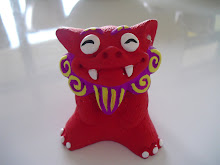



So, we took Thursday off. Thursday was a like a bank holiday so the kids were off school and me and James did a kind of educational trip. It was a bit "My two gaijin dads" like, but there you go.
First stop was the kid's park, which you see above. Now, those are slides, aren't there? Ridiculously well designed play area. But the Japanese do love building things well.
We then went to the preserved WWII bunker right next door.
Okinawa took it real bad in the war. Real, real bad. There were 500,000 inhabitants and 500,000 invading Americans. But before the invasion was a bombing campaign that involved 1000 planes in one massive flyby. Naha, the city next to where I'm living, was levelled to the point where only 10% was left! That was October 10th, 1944. It was only the beginning.
The Japanese had only 100,000 troops on the island, most of them conscripts. The battle for Okinawa, which started with the American invasion on March 26th of the satellite islands of Kerama, did not go well from them, and from the start the propaganda machine had the civilians convinced that the arriving Americans would rape and plunder and destroy and torture. Suicide was seen as the honourable way out; worse, the army got into the habit of forcing mass suicide on civilians. Many on the Kerama islands were forced to commit suicide. One man used a razor on his family and then himself. Some borrowed grenades from the military, then gathered their family in one room of the house and pull the pin.
The mainland of Okinawa was landed on April 1st and slowly swept through, by May they had the Japanese army, or what was left of it, pinned down in the South of the island aroundthe bunker I visited, which was in fact their Naval headquarters. The situation was bad, there were no toilets inside, little medical equipment, and the nearest water supply was a well 200m from the entrance. The Americans captured the landing strip to the south of the bunker and then it became a matter of days.
The Japanese commanders decided that it was important to delay the Americans as much as possible in Okinawa and so delay the coming invasion of the Japanese mainland. Their tactic was to move themselves into civilian areas and fight from there. The civilian cost in the battle, already high, massively increased due to this decision. There is still ill feeling in Okinawa to this day about that decision.
The taking of the bunker was a lesson in Japanese bloody mindedness: the main exit was approached by the American troops and 4000 Japanese soldiers charged out towards the American guns. Many of the soldiers had run out of ammunition and were using swords and spears. The died to the last man.
Inside the bunker, a further 175 officers committed suicide, this included Rear Admiral Ota who was in charge of the Navy forces of the island. Before he killed himself he sent a telegram to Tokyo praising the courage of the Okinawan people.
Ten days after this, the final Japanese General on the island was dead by his own hand, effectively bringing the Battle for Okinawa to a close.
In Okinawa they call it the Typhoon of Steel, 80 odd days that killed 200,000 people, burnt most of the island to the ground and reshaped many, many hills. Nearly half the island was dead, most of the infrastructure was destroyed. The Americans found themselves with an immense rebuilding job which, to be fair, they did very well, running the island up until the early 1970's.
The pictures above are the best ones I took from the bunker. The top one is a picture of a battle as the bullets and shells whizzed by.
To put things in perspective, the Americans fired 2,716,691 shells at the island, that's nearly 5 shells per person!
12,520 Americans died
188,136 Japanese
Of which
65,908 were soldiers from Japanese mainland
28,228 were soldiers from Okinawa
56,861 were civilians who fought through conscription
37,139 were civilians caught in the battle
It's different there to the monuments I've been to in Europe, but I couldn't say why.















